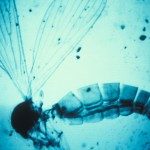Link to Pubmed [PMID] – 32581095
Link to DOI – e00343-2010.1128/JVI.00343-20
J Virol 2020 Aug; 94(18):
Zika virus (ZIKV) is an emerging flavivirus, mainly transmitted by mosquitoes, which represents a global health threat. A common feature of flavivirus-infected cells is the accumulation of viral noncoding subgenomic RNAs by partial degradation of the viral genome, known as sfRNAs, involved in immune evasion and pathogenesis. Although great effort is being made to understand the mechanism by which these sfRNAs function during infection, the picture of how they work is still incomplete. In this study, we developed new genetic tools to dissect the functions of ZIKV RNA structures for viral replication and sfRNA production in mosquito and human hosts. ZIKV infections mostly accumulate two kinds of sfRNAs, sfRNA1 and sfRNA2, by stalling genome degradation upstream of duplicated stem loops (SLI and SLII) of the viral 3′ untranslated region (UTR). Although the two SLs share conserved sequences and structures, different functions have been found for ZIKV replication in human and mosquito cells. While both SLs are enhancers for viral infection in human cells, they play opposite roles in the mosquito host. The dissection of determinants for sfRNA formation indicated a strong cooperativity between SLI and SLII, supporting a high-order organization of this region of the 3′ UTR. Using recombinant ZIKV with different SLI and SLII arrangements, which produce different types of sfRNAs or lack the ability to generate these molecules, revealed that at least one sfRNA was necessary for efficient infection and transmission in Aedes aegypti mosquitoes. Importantly, we demonstrate an absolute requirement of sfRNAs for ZIKV propagation in human cells. In this regard, viruses lacking sfRNAs, constructed by deletion of the region containing SLI and SLII, were able to infect human cells but the infection was rapidly cleared by antiviral responses. Our findings are unique for ZIKV, since in previous studies, other flaviviruses with deletions of analogous regions of the genome, including dengue and West Nile viruses, accumulated distinct species of sfRNAs and were infectious in human cells. We conclude that flaviviruses share common strategies for sfRNA generation, but they have evolved mechanisms to produce different kinds of these RNAs to accomplish virus-specific functions.IMPORTANCE Flaviviruses are important emerging and reemerging human pathogens. Understanding the molecular mechanisms for viral replication and evasion of host antiviral responses is relevant to development of control strategies. Flavivirus infections produce viral noncoding RNAs, known as sfRNAs, involved in viral replication and pathogenesis. In this study, we dissected molecular determinants for Zika virus sfRNA generation in the two natural hosts, human cells and mosquitoes. We found that two RNA structures of the viral 3′ UTR operate in a cooperative manner to produce two species of sfRNAs and that the deletion of these elements has a profoundly different impact on viral replication in the two hosts. Generation of at least one sfRNA was necessary for efficient Zika virus infection of Aedes aegypti mosquitoes. Moreover, recombinant viruses with different 3′ UTR arrangements revealed an essential role of sfRNAs for productive infection in human cells. In summary, we define molecular requirements for Zika virus sfRNA accumulation and provide new ideas of how flavivirus RNA structures have evolved to succeed in different hosts.

